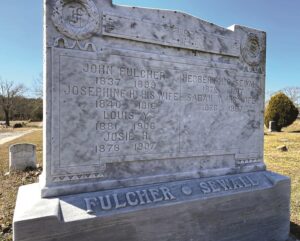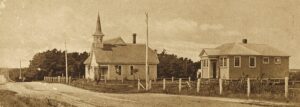Swashbuckling pirates and mooncussing scoundrels, real or fictional, have long been characters in the Cape Cod story. So, too, have castaways, washed ashore after a shipwreck, or put ashore, as in the case of young Emanuel Caton.
The story goes that sometime after 1812 Caton was marooned at Provincetown, then a place of 160 impoverished fishing families eking out a living after the deprivations of the Revolutionary War and the War of 1812.
Having run away from his Lisbon home, the teenage Caton sailed on a merchant vessel that was boarded by pirates who, sparing him, made every other crew member walk the plank. After months at sea marauding and plundering, the pirates released him, putting him ashore near today’s Herring Cove. Found wandering the lonely back shore, exhausted and frightened, Caton was said to have been taken in by the Bowley family, and Provincetown became his home.

A newspaper story at the time described Caton as a handsome, stout man with black curly hair. Brass “pirate” earrings dangled from his ears, perhaps a mark of his adventures at sea.
In January 1823, he married Jemima Atkins of Wellfleet. Six children were born to the couple, and two sons and a daughter survived and were reared in Provincetown. Emanuel Jr. and Joseph both became whalemen, and Joseph was master of the schooner John Adams when it was captured (the crew was released) and burned by the CSS Calhoun during the Civil War.
For generations, talk of the Caton family revived tales of pirate treasure believed buried at “Money Hill” where Caton had been abandoned. Though Caton “closed up tight as a clam” whenever talk of pirates came up, he did tell of them hauling their ship onto the beach and removing a heavy box that four men struggled to carry to the hill. Whether the story was a reliable account or the audacious invention of a teenage boy, it was enough to inspire many old-timers to go in search of the treasure. Little more than bits of rusted metal were ever found.
If Caton was the first in a long line of Portuguese people who by the early 20th century would change the demographics of Yankee Provincetown, Eastham’s John Fulcher was the first to establish that now widespread English family surname on Cape Cod.
When the British brig Margaret, carrying a cargo of coal for Boston from Hartlepool, England, came ashore at Nauset on an April morning in 1852, her fate was decidedly better than that of other vessels that lost their way on the treacherous outer bars. Though the ship and cargo were a total loss, the entire crew was saved, including 14-year-old apprentice Fulcher, who, depending on the story, was either plucked with crewmates from the foundering vessel or washed ashore clinging to a mast with the ship’s cat tucked in his jacket.
When the time came for the survivors of the Margaret to return to England, young John remained in Eastham. He lived with several different families until his 1859 marriage to Josephine Helena Doane (1840-1916), the daughter of Capt. Ezekiel Doane, whose homestead occupied the former Governor Prence farm. The couple had 10 children, all of whom survived, though two died as young adults. For some years John continued at sea but by 1880 he had come ashore to farm that same Prence land.
By August 1889, Eastham was awakening to the Universalism that had been spreading across the Cape for 50 years. An alternative to more conservative faiths, Universalism rejected predestination — the belief that only a chosen few would be saved — and subscribed to the doctrine that everyone would find salvation and spend eternity in Heaven with God.

The people of Eastham gathered to organize a parish, and with more than two dozen charter members, a constitution and bylaws were adopted. Land on Samoset Road was donated by William Henry Nickerson for the building of a “plain little chapel” where “the love of God would be proclaimed in all its fullness and beauty.” Parish president John E. Ryder, a carpenter, went about the town soliciting subscriptions.
The first person he called on was Capt. Edward Penniman, born in Eastham in 1831. Penniman had gone to sea at 11 and after several lengthy voyages returned to town in 1868 to build his handsome home — now a National Park Service property — at Fort Hill.
Penniman contributed $100 to the chapel fund and chaired the building committee. A ladies’ circle was formed, led by Mrs. John E. Ryder, who organized “entertainments” to raise funds for the chapel. The ladies had always been “the strongest supporters of nearly every good institution,” the Yarmouth Register reported.
Many small donations were received, made with “as much zeal and devotion to the cause, and in a few instances a greater sacrifice,” said John E. Ryder. Among the donors worthy of special mention was the Fulcher family. “Seldom do you see the names of father and mother with the names of their ten children on a subscription list,” noted the Register. “The example of educating our children to give is worthy of our attention, and when one man with a family of ten can set such an example, what is to hinder those whose families are smaller from imitating him.” Together, Fulcher family members contributed more than $60.
The picturesque chapel, combining Gothic Revival and Queen Anne elements, was dedicated on Jan. 29, 1890. Until 1961, the Eastham Universalist Church shared a preacher with the First Unitarian Church of Brewster. That year, the two denominations merged, and the churches eventually consolidated, the Brewster congregation becoming the owner of the “perfect gem” that became known as the Chapel in the Pines.
By the late 1970s, with most services being held in Brewster, the chapel was put up for sale, and in 1979 the Nauset Fellowship, formed to preserve the landmark building, purchased it. The fellowship continues today as a lay congregation devoted to community and, like the chapel’s original supporters, to those “reforms necessary to bring human society to a higher plane.”



